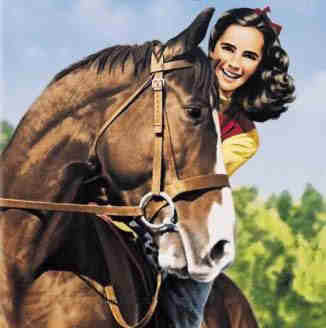Sole Man
some Tips for Starting off on the Right Foot
Rebecca Colnar
Your horse should see a farrier every four to eight weeks,
ideally. You count on him or her to help if your horse needs
corrective shoeing, needs to be specially shod for an event or
when you need advice on hoof care.
"Your farrier should be clean, mannerly and presentable, and not
abusive toward the horse," says Jim House, an AFA Certified
Journeyman in Sheridan, Wyo. "Your farrier should also be
punctual. And he or she should be able to offer a complete
shoeing service, including trimming and corrective shoeing, and
they carry pads and wedges just in case your horse needs that."
The farrier's willingness to educate the owner is also
fundamental.
"You want someone who takes time to explain, for instance, why
your horse might need certain shoes. A good farrier doesn't mind
spending time with a client," House says. He also knows his
capabilities with regard to correcting a problem, and knows when
to seek veterinary advice.
In fact, your vet and farrier should be able to work together.
"The veterinarian uses his knowledge of the medial and anatomic
aspects of the equine foot to diagnose problems and design
appropriate treatments," explains Dr. Steve O'Grady, owner of
Northern Virginia Equine Practice in The Plains, Va. The farrier
uses his or her technical and mechanical skills to implement the
treatment.

A good farrier will put you on a schedule so your horse will be
shod on a regular basis.
The most important aspects of horseshoeing are trimming the foot
and fitting the shoe. When the horse is brought out to be shod,
the farrier should watch it walk, standing in front and behind.
This gives a quick indication of how the horse's foot contacts
the ground.
The farrier should evaluate the foot from all directions so
imbalance can be noted before trimming. Rather than relying on a
hoof angle -- a tool which measures the angle of the hoof --
which is rarely appropriate for the conformation of the
individual horse's limbs, O'Grady says it's often more beneficial
to trim the foot so the dorsal (front) surface of the hoof wall
and the pastern angle are parallel. Ideally, the angle of the
heel should match the angle of the toe.
"What you want to see is a balanced, symmetrical hoof," agrees
House. "A balanced hoof means your » horse will travel properly."
The sole should be trimmed only enough to cosmetically remove the
exfoliating (flaking-off) material. The full thickness of the
sole is needed to protect the internal structure of the foot. The
bars in the heel area are left intact, and the heels are trimmed
to the widest part of the frog. Excess toe and any flares are
rasped from the exterior of the foot.
The frog should be trimmed as little as good hygiene will allow
and ideally, should be about level with the ground surface of the
foot.
Look at training when selecting a farrier. The American Farriers
Association certifies farriers at three levels: intern, certified
and certified journeyman. The farrier who does hot shoeing,
including making handmade shoes, will usually be at the
journeyman level. This level of expertise also enables the
farrier to perform corrective shoeing.
One can learn the farrier trade through a formal apprenticeship,
usually three years, or by attending a recognized farrier school.
After finishing farrier school, the graduate should spend time
working with a reputable horseshoeing mentor.
It's important, no matter how he learned the trade, that your
farrier keep up with the latest trends in shoeing and continue
his education through clinics.
For a free brochure on how to choose a farrier and an
AFA-certified farrier directory, send a self-addressed, stamped
envelope to American Farrier Association, 4059 Iron Works Pike,
Lexington, KY 40511.
Derek A. Poupard, a well-known farrier in The Plains, Va., also
contributed to this article.